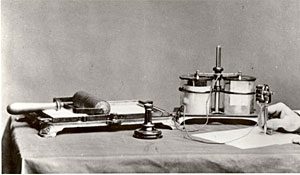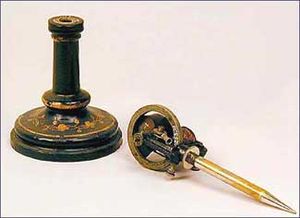Edison's Electric Pen

One of Thomas Edison’s lesser known inventions was the electric pen, the first high speed copying system for documents.
Edison became interested in stencil copying methods, where writing or drawings were produced on a sheet of paper not with ink, but by making tiny pinpricks, sort of like the needle of a sewing machine. Then the paper was put in a press, and inked on one side. The ink would flow through the holes and reproduce the writing on a clean sheet. This could be done repeatedly to make multiple copies.
Edison’s mechanized stencil making with the electric pen. He developed a tiny electric motor, but rather than a rotating motor, he used an oscillating motor that moved up and down at high speed. He connected this motor to a hollow tube, which the writer held. A sharp stylus ran through the tube. By tracing letters, the electric pen produced a stencil at high speed but without tearing up the sheet. The first words etched by the pen were "Now is the winter of our discontent," from Shakespeare’s Richard III, Edison's favorite play.
An “autographic press” kit, which included an electric pen, a small battery, a press, ink, and supplies cost $30 when Edison put it on the market in late 1875. The next year, he put it on display at the great Centennial Exhibition in Philadelphia to generate publicity. It won a Bronze Medal, which Edison’s chief assistant Charles Batchelor subsequently lost on the ferry to New Jersey. Edison also began selling the rights to make the pen system to Western Electric, which he reasoned would be more profitable than making them himself. As many as 60,000 were sold over the years.
The electric pen had a brief life, however. The use of the stencil press to produce copies even survived through the 20th century. But the electric pen itself faded into obscurity, bettered by other cheap, simple, stencil-making technologies, all of which were eventually overtaken by the typewriter in the late 1880s. The rest of this system remained in use for many years in various forms, the most famous being the Mimeograph (originally marketed with the inventor’s permission as the Edison Mimeograph) by a Chicago manufacturer.
